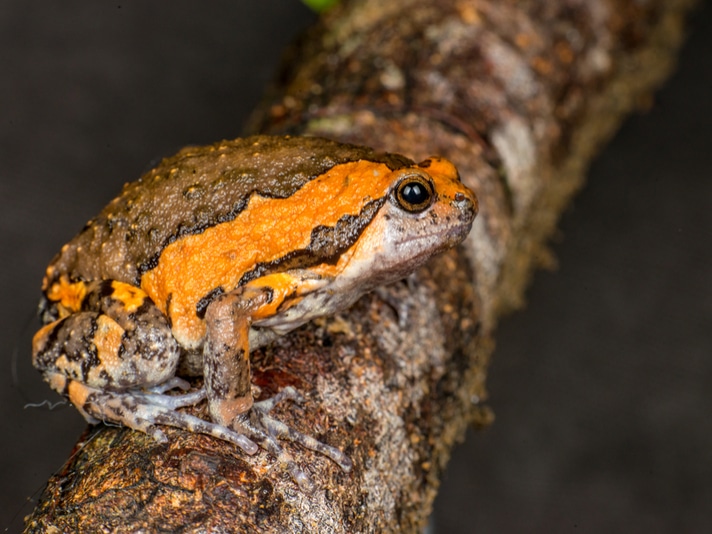Expert care tips for Kaloula pulchra aka the chubby frog
The Asian painted bullfrog (Kaloula pulchra) is a somewhat cute and comical narrow-mouthed toad from Asia. It has established itself as something of a regular in the international pet trade; it goes by many pseudonyms, but it is perhaps best known by its slightly more accurate trade name of chubby frog.
Widespread throughout southern Asia, it is a highly adaptable species that makes the most of encroaching human habitat and is believed to be increasing in population despite its collection for both the food and pet markets. It has, over time, been introduced to numerous island countries, where it has established populations in an almost pestlike manner, a trait that endears itself well to our hobby by allowing wild-caught specimens to settle into captivity quickly, even when husbandry conditions aren’t 100-percent perfect.
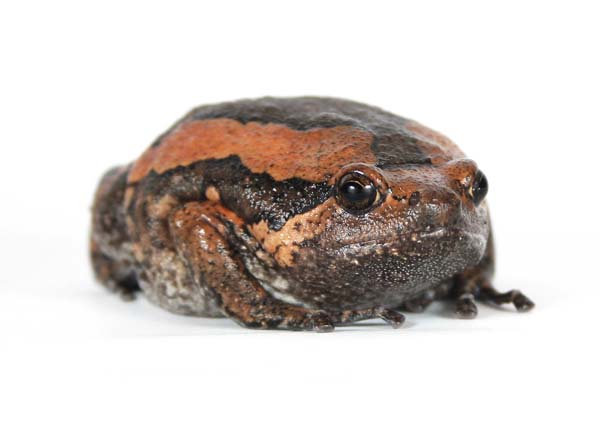
Photo by Andrew Tillson Willis
The chubby frog is prolific, and wild populations may be growing despite this frog's collection for both food and pet markets.
Growing to approximately 2 to 3 inches, the chubby frog is, as its name suggests, a rather rotund frog, stocky and robust in stature, with a short, rounded snout and short limbs suited better to crawling into crevices than jumping long distances. Its mottled-brown background, marked by wide, black-bordered bands of creamy yellow to pale orange, is far from the images that its other names of painted bullfrog and beautiful Kaloula conjure in the mind. However, this may change with recent imports containing albino individuals and possible hypo mutations. The underside is a dirty, creamy shade of gray, and the metatarsal tubercle is developed into a hard spadelike projection that enables specimens to burrow backward into the earth with surprising speed.
Captive Husbandry
Chubby frogs make undemanding and hardy captives, requiring relatively little space. A standard 15-gallon enclosure (24 inches long, 12 inches wide and 12 inches tall) will adequately house two to three adults. For breeding, I suggest, at a minimum, a group of five to six housed in a 30-gallon enclosure (48 inches long, 12 inches wide and 12 inches tall).
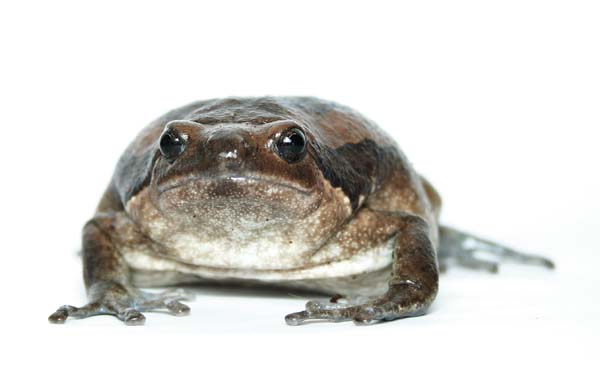
Photo by Andrew Tillson Willis
Chubby frogs make undemanding and hardy captives, requiring relatively little space.
There are many choices for a suitable substrate, but my preference is for a coco-based blend of rehydrated coco-fiber mixed with a small amount of composted bark and leaf litter. This provides a free-draining substrate and moisture content is easily controlled, which will prove very important during the breeding cycle. As the chubby frog is a burrowing species, the substrate should be relatively deep and damp, but not sodden.
Pieces of cork bark, flat rocks and broken terracotta pots can be arranged on the surface to form hides and crevices for the frogs to squeeze in to or burrow under. Plants, such as pothos and ferns, can be added for further aesthetics if you wish.
Provide a water bowl at all times. It should be a large, shallow, heavy ceramic bowl, such as a dog bowl, so as not to be disturbed by burrowing activity. As with all amphibians, water should be dechlorinated either through allowing it to stand for 24 hours or by treating it with an aquarium water conditioner. It is best to refresh the water on a daily basis, so as to avoid the build up of potentially harmful waste products.
Temperatures in the enclosure can be maintained using a thermostatically controlled heat mat set between 75 to 80 degrees Fahrenheit in the daytime, with a drop in night-time temperatures to 68 to 70 degrees. Due to the deep substrate depth, heat mats are ideally placed on the side or back of the enclosure and insulated with polystyrene tiles to reflect heat back into the terrarium. Do not be tempted to use foil or foil-lined polystyrene to insulate your heat mats, as this can cause hot spots, resulting in burnt-out heaters or cracks in a glass tank.
Humidity should be maintained around the region of 70 percent; this will be largely achieved through release of moisture from the damp substrate, but it can be helped and replenished through regular misting. If using a screen-topped enclosure, you may find it beneficial to restrict some of the ventilation by placing glass or clear acrylic over part of the mesh to help retain humidity.
Lighting is not essential unless live plants are used in the enclosure, but it will help define a day/night cycle that could come in handy for breeding as well as adding to your viewing pleasure. I personally have not found any advantage in providing ultraviolet lighting to chubby frogs and find a good dietary supplement to be adequate in maintaining levels of D3 and calcium. If you choose to light the enclosure, I advise using a standard freshwater aquarium tube or one of the many daylight compact lamps available, set to illuminate the enclosure for around 12 hours a day.
Frog Food
In the wild, chubby frogs are reported to feed largely on ants and termites, but pet chubby frogs will take readily to any suitably sized commercially produced feeder insects. Adults can easily take medium-to-large crickets, but they typically show a preference for a larger number of smaller-sized insects, such as small-to-medium crickets, mini mealworms, mealworm beetles and waxmoth larvae.
Food items should be gut-loaded with a variety of fresh fruit and vegetables before being offered to the frogs. I recommend dusting them once a week with a good calcium and vitamin supplement.
Breeding in the Wild
One of the most interesting things about chubby frogs is their breeding and rapid development, but sadly this is rarely observed in captivity. Given that chubby frogs are a cheap, readily available species, breeding them is not going to set you back much initial outlay, but likewise, it isn’t going to make you any money. However, it is an enjoyable experience that will teach you a cycle and techniques that can be adapted to breed numerous microhylid species in the future.
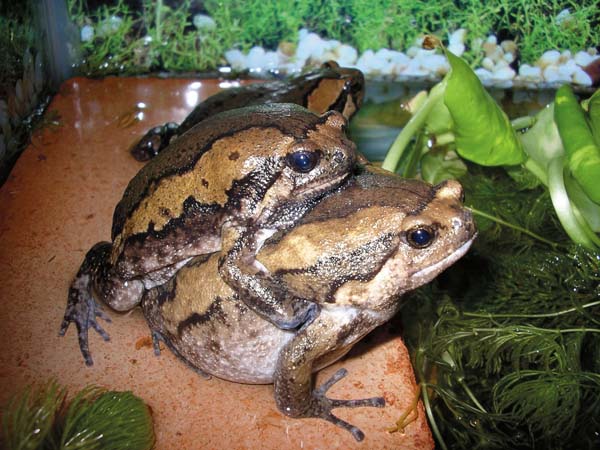
Photo by Andrew Tillson Willis
In the wild, chubby frogs traditionally utilize rain pools and flooded ditches for breeding. These captive frogs are locked in amplexus.
In the wild, chubby frogs breed explosively after heavy rains in India. This can be between April and May, while in other parts of the frog’s range it can be year-round. They traditionally utilize temporary rain pools and flooded ditches for breeding, which has led to them evolving a very speedy development that can take as little as two weeks. This fast rate of growth ensures that the majority of their offspring are out of the water before the pools dry up. With the encroachment of civilization, they have adapted to using garden features and animal water troughs, which provide a more permanent source of water and result in a higher survival rate.
In order to reproduce these frogs in captivity, we have to mimic the climatic conditions they would experience in the wild. Depending on the origin of the specimens you are working with, the cycle can vary slightly in temperature. Animals from Vietnam appear to require more cooling than animals of Indonesian or Malaysian origin. Given that they have been the most prevalent sources of these animals in the trade over the last couple of years, I will cover these temperature differences later in this article for you. Scientific literature tells us that specimens from Singapore face very little change in temperature during a typical year, and so these may prove to be the easiest to breed in captivity if it is possible to acquire them.
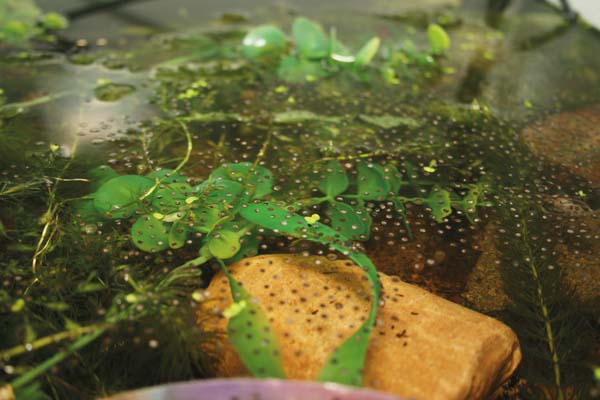
Photo by Andrew Tillson Willis
These chubby frog eggs will hatch and develop quickly, most probably within a span of two weeks.
While on the subject of localities, there are, at the time of writing this article, three recognized subspecies of Kaloula pulchra. These are the nominate K. p. pulchra, the Hainan digging frog (K. p. hainana) from the Hainan Island in the South China Sea, and K. p. macrocephala from Tonkin in northern Vietnam. There is still discussion over the true taxonomic stature of these subspecies, whether they should be treated as species in their own right and if any other subspecies occur over the natural range.
Captive Breeding
For the best chance of success, I advise starting with a breeding stock of six to 12 animals at a 2:1 or 3:2 ratio of males to females. The competition between males will stimulate their breeding activity, and their calling will help to stimulate the females. Sexing of adults is straightforward. The male’s throat is dark, dusky gray to black, even when out of breeding condition in comparison to the female’s throat, which retains the pale coloration of the rest of the ventral surface.
Once you have your group settled into their enclosure and of a good size and weight, the cycling can begin. It is usually easiest to time your cycle to coincide with the late autumn or early spring, when temperatures are low enough to carry out the cycle without artificial cooling.
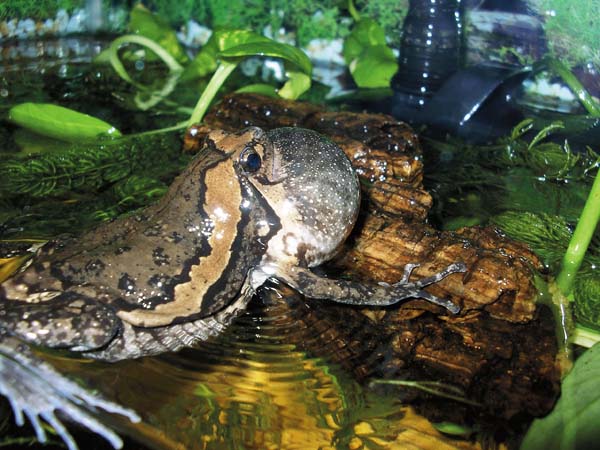
Photo by Andrew Tillson Willis
A male calls to attract a mate.
The initial stage of the cycle is the creation of a cooling period to induce the chubby frogs to go into a state of brumation. They do not hibernate to the same extent as temperate species, nor do they aestivate like frogs from savannah regions. They burrow into the soil to avoid desiccation and cool temperatures, but they are ever ready to emerge to feed on a warm, wet evening. To help stimulate brumation behavior, humidity should first be dropped to the 50- to 60-percent range and the surface of the substrate allowed to dry slightly. This will encourage the frogs to burrow down as you begin to lower the temperature. The amount of food being offered can also be decreased at this time, but they do not need to be starved before or during brumation. I stop offering crickets at this time and instead introduce a colony of woodlice or similar, so food is present for the frogs if they wish to forage for it.
Over a period of two to three weeks temperatures should be gradually lowered. For specimens imported from Indonesia and Malaysia, I have found a low of 60 degrees to be sufficient. For specimens originating from Vietnam, I have had greater success when lowering the temperature further to around 54 degrees.
As temperatures get to around the 68-degree mark, you can remove terrarium décor and introduce more substrate, allowing the substrate surface to dry further until the first inch or so is almost dry. This will force the frogs to burrow deeper to preserve moisture, and it will help insulate them from the cold temperatures they will be exposed to.
If you usually provide lights in your enclosure, gradually decrease their hours of operation from 12 to around 8 to 10 hours a day. Light cycles do not appear to be important when breeding these frogs. I have had success in breeding this species with no artificial lighting provided, but everything you do to enhance breeding triggers can ultimately increase your chances of a successful mating.
These new levels can be maintained for a period of four to six weeks. If activity is witnessed in the evenings, a small amount of food may still be offered, but throughout the process, this disturbance should be kept to a minimum. Frogs can be carefully uncovered occasionally to ensure they are still in good health. Monitor them for signs of desiccation, discoloration of the skin or sudden weight loss. If any signs of ill health are noticed, remove the affected individual to a quarantine tank and gradually bring it back to normal maintenance levels.
At the end of four to six weeks, gradually raise temperature and humidity back to normal levels over the span of two weeks. The frogs may not begin to become active until humidity levels are raised further to around 85 to 90 percent and the normal levels of moisture in the substrate are reinstated. Once your frogs are awake and active, its time to introduce them to the first of the two rain chamber designs you will use in your breeding attempt.
The basis for the rain chamber should be a large, deep aquarium. You can use the same aquarium for both breeding setups and for rearing the tadpoles, so it’s worth buying as large an enclosure as you can afford. I recommend a minimum of 36 inches tall, 18 inches wide and 18 inches long.
Your first rain chamber system will use a circulatory rain system, flushing water through the substrate and simulating the effect of heavy monsoon rains. There are several ways you can emulate this. One way, and my preferred option, is to install a drain and external sump, where the water will be filtered and pumped back to the rain bar at a variable flow of 400 to 1,200 liters per hour. This system has some advantages, particularly in maintaining water quality, but it is a little over the top for the hobbyist breeder. The easier option is to install a false bottom and reservoir in the base of the aquarium using a plastic “egg-crate” grid supported on PVC pipe columns with a filter and pump system mounted below. Pump size depends on enclosure size, but the reservoir should only need to be slightly deeper than the pump, which is usually around 2 to 3 inches.
The first step in creating this rain chamber is to install a small aquarium filter and the pump and tubing for your rain system. Place the plastic grid over the top of these. This should be a tight fit in the aquarium and well-supported to take the weight of the substrate and frogs. Next, you will lay a barrier that will allow water to drain freely but prevent substrate washing away with it. Sheets of fine-filter foam, weed-suppressant membrane or other close-weave cloth work well for this. Cut them slightly larger than required, and lap them up against the glass to form a seal that will prevent substrate from making its way down around the edges. Once done, you can introduce your substrate. This should be the same free-draining mix we discussed earlier and deep enough for the frogs to burrow fully. Simple décor may be included to provide shelter from the rain. The rain bar is usually homemade, and the size depends on enclosure size. There bar is either perforated with small holes or there are nozzles installed to allow the water to rain down from the top of the enclosure.
The rain system should be run, initially, for several hours early evening and early morning, increased after a couple of days to run all night and occasionally running for a 24-hour stint. Once in this setup, you should note an increase in the frogs’ activity. Males will begin calling in chorus, and females will begin to fatten with eggs. At this time, feeding should be increased. On a daily basis, offer as much as they will take to ensure they are fattened up and ready for their imminent breeding attempt. After two to three weeks in this first rain chamber, your frogs should be near ready to breed. Now it’s time to strip out and rearrange the rain chamber to prepare for spawning.
The same rain system can be cleaned and reinstated. Remove the egg crate, barrier and previous substrate, and replace it with a substrate of fine gravel laid in the base and sloped up around the sides to provide a gradient and some land area, with a water level of 2 to 3 inches at the deepest section. Pieces of rock and broken terracotta pot can be placed to provide further platforms for the frogs to haul themselves out of the water. Plants of either the live or plastic variety should be added to the water, providing dense vegetation with some open areas. Leaves, twigs and other such floating debris give the impression of a temporary puddle, while releasing beneficial tannins into the water that contain antifungal and antibacterial properties. Water temperature should be maintained at around 75 to 77 degrees, and the rain system should run for several hours in the early evening only. Feeding at this time can be reduced back to the frogs’ normal feeding regime or slightly less. The chubby frogs should be focused on things other than their stomachs at this point, and reducing the feedings will also help prevent drowned crickets.
After a day or two in this rain chamber, males should be calling loudly in chorus. They will call both from land areas and while floating on the surface of the water. Loop tapes of males calling can be made easily thanks to websites, such as YouTube, and are of benefit to encourage calling in stubborn males or when working with breeding groups lacking in males.
If a female comes into close proximity of a waiting male, amplexus will be attempted. Literature states that males have difficulty amplexing, and so they secrete a gluelike substance that holds them in place while breeding until the female sloughs its skin and releases him. Having made numerous breeding attempts with chubby frogs over a number of years, amplexus appears to be rather easily achieved and I have yet to witness a male gluing itself to the female.
If breeding behavior is not observed after several days in the rain chamber, then try flushing with cooler water and turning off the rain for a day or two. Mating usually occurs in the early hours of the morning, during the off-cycle of the rain. Once spawning has taken place, the adults should be removed from the rain chamber and returned to their usual living quarters. At this point, the rain is turned off.
The small eggs, with their black-and-white poles, float at the surface of the water, forming a film of spawn. Fertile eggs will always sit black side up and will turn to right themselves if disturbed. At a temperature of 75 degrees, fertile eggs will develop rapidly and hatch within 24 hours. The newly hatched tadpoles will fall to the base of the aquarium and lay lifeless for a period while they absorb their yolk sacs before becoming free-swimming and starting to feed. Once all eggs have hatched, the rain system can be removed from the aquarium, the water level raised and an air-powered filter added.
Chubby frog tadpoles have flat, ovoid bodies, with eyes positioned toward the sides. They can be maintained on a diet of finely crushed fish flake and Spirulina algae powder, offered in small amounts, three or four times a day. The tadpoles will pull food down from the surface and graze on sunken food. Be careful not to overfeed, as uneaten food will quickly foul the water.
As mentioned earlier, chubby frog tadpoles grow fast. With a good feeding regime, the first froglets can be expected in as little as two weeks, with subsequent froglets emerging over a further two-week period.
Morphing at around three-eighths of an inch, froglets can be housed in small groups on a basic substrate, such as damp paper towels or fine-filter foam, misted lightly once or twice a day and cleaned every day or two. Suitable foods at this stage include hatchling crickets, fruit flies and springtails, with a daily helping of calcium and vitamin supplements. If kept clean and well-fed, the froglets are largely undemanding. They will continue to grow quickly and have the potential to live for 10 years or more.
I hope that this article will inspire some of you to have a go at breeding chubby frogs and maybe some of our other more readily available microhylids.
ANDREW TILLSON-WILLIS has more than 17 years of experience keeping and breeding a wide range of amphibians. He is owner of Pollywog, the UK’s leading commercial amphibian breeding facility. Visit him at pollywog.co.uk.

